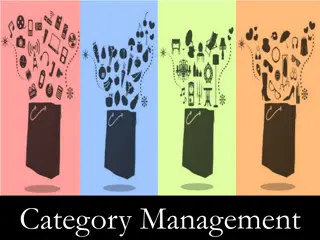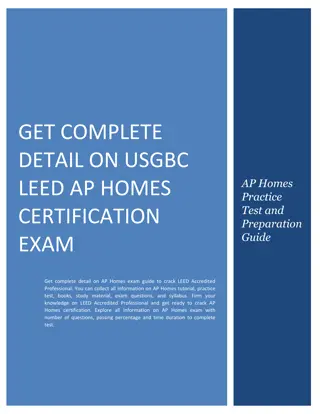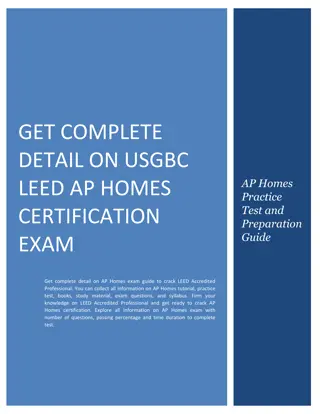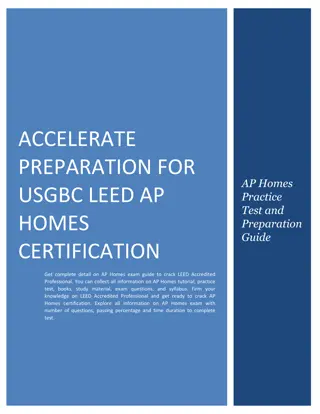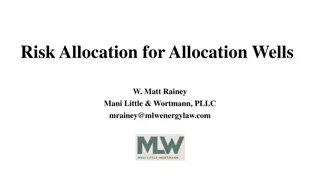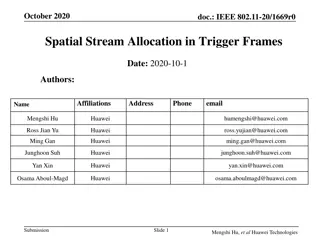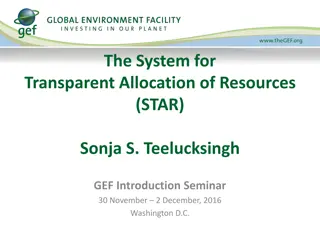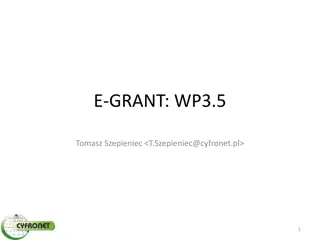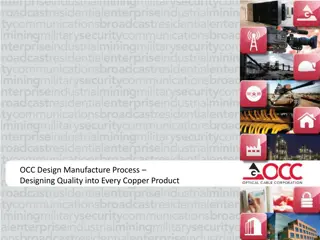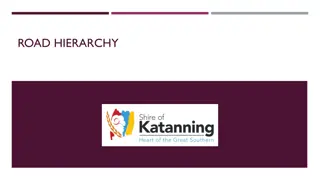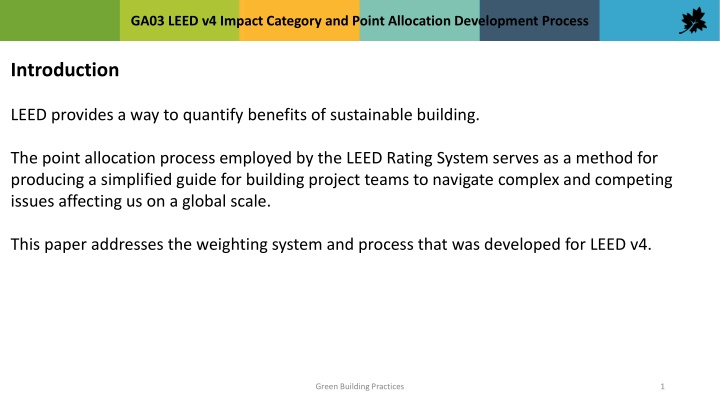
LEED v4 Impact Category and Point Allocation Process Overview
LEED v4 offers a simplified guide for building project teams to navigate complex global issues. It introduces a new point allocation process that focuses on social, environmental, and economic goals. The system incentivizes compliance with requirements to achieve sustainable outcomes. Explore the development process, background, and structure of LEED v4 in this insightful paper.
Download Presentation

Please find below an Image/Link to download the presentation.
The content on the website is provided AS IS for your information and personal use only. It may not be sold, licensed, or shared on other websites without obtaining consent from the author. If you encounter any issues during the download, it is possible that the publisher has removed the file from their server.
You are allowed to download the files provided on this website for personal or commercial use, subject to the condition that they are used lawfully. All files are the property of their respective owners.
The content on the website is provided AS IS for your information and personal use only. It may not be sold, licensed, or shared on other websites without obtaining consent from the author.
E N D
Presentation Transcript
GA03 LEED v4 Impact Category and Point Allocation Development Process Introduction LEED provides a way to quantify benefits of sustainable building. The point allocation process employed by the LEED Rating System serves as a method for producing a simplified guide for building project teams to navigate complex and competing issues affecting us on a global scale. This paper addresses the weighting system and process that was developed for LEED v4. Green Building Practices 1
GA03 LEED v4 Impact Category and Point Allocation Development Process Background Early Versions of LEED Technical Advisory Group (TAC) LEED 2009 Weighting System Impact categories were derived from the Environmental Protection Agency s TRACI categories, which are widely used to conduct Life-Cycle Assessments (LCA). Green Building Practices 2
GA03 LEED v4 Impact Category and Point Allocation Development Process Background LEED v4 The LEED Steering Committee approved a set of new Impact Categories that focus on the social, environmental and economic goals of LEED and measure each strategy according to their ability to meet those goals. Green Building Practices 3
GA03 LEED v4 Impact Category and Point Allocation Development Process Background LEED v4 What should a LEED project accomplish? Green Building Practices 4
GA03 LEED v4 Impact Category and Point Allocation Development Process Background LEED v4 LEED v4 also generated another innovation a web-based tool that enables multivariate associations between strategies and impacts. The LEED Rating System allocates points to incentivize building project teams to comply with requirements that best address the social, environmental, and economic outcomes identified by USGBC. Green Building Practices 5
GA03 LEED v4 Impact Category and Point Allocation Development Process Overview of LEED Structure LEED Rating System The LEED Rating System is a voluntary, consensus driven, internationally recognized green building certification system providing third-party verification that a building or community was designed and built using strategies aimed at improving performance across metrics such as energy savings, water efficiency, CO2 emissions reduction, improved indoor environmental quality, and resource stewardship. Green Building Practices 6
GA03 LEED v4 Impact Category and Point Allocation Development Process Overview of LEED Structure LEED Rating System Design Guide Verification system used to measure progress in defined performance goals Encourages Integrated Project Delivery Collaboration vs Isolation Green Building Practices 7
GA03 LEED v4 Impact Category and Point Allocation Development Process Overview of LEED Structure LEED Credit Categories Location and Transportation (LT) Sustainable Sites (SS) Water Efficiency (WE) Energy and Atmosphere (EA) Materials and Resources (MR) Indoor Environmental Quality (EQ) Integrated Process Innovation (IN) Regional Priority (RP) Smart Location and Linkages (SLL) Neighborhood Pattern and Design (NPD) Green Buildings and Infrastructure (GBI) Green Building Practices 8
GA03 LEED v4 Impact Category and Point Allocation Development Process Overview of LEED Structure LEED Credits Prerequisites Required Credits - Optional Green Building Practices 9
GA03 LEED v4 Impact Category and Point Allocation Development Process Overview of LEED Structure Achieving LEED certification requires: Meet the Minimum Program Requirements (MPRs) Satisfy all prerequisites Earn a minimum number of credits for the desired level of certification Green Building Practices 10
GA03 LEED v4 Impact Category and Point Allocation Development Process LEED System Goals Referred to as Impact Categories Reverse Contribution to Global Climate Change Enhance Individual Human Health and Well-Being Protect and Restore Water Resources Protect, Enhance and Restore Biodiversity and Ecosystem Services Promote Sustainable and Regenerative Material Resources Cycles Build a Greener Economy Enhance Social Equity, Environmental Justice, and Community Quality of Life Green Building Practices 11
GA03 LEED v4 Impact Category and Point Allocation Development Process Point Allocation Methodology Credits that significantly contribute to accomplishing the system goals of the seven impact categories are given more emphasis by being assigned more points. Green Building Practices 12
GA03 LEED v4 Impact Category and Point Allocation Development Process Point Allocation Methodology Green Building Practices 13
GA03 LEED v4 Impact Category and Point Allocation Development Process Impact Category Weighting Layer Applied to the overall weighting process Each of the LEED s Impact Categories vary in scale, scope, severity, and relative contribution from the built environment to these impacts. Green Building Practices 14
GA03 LEED v4 Impact Category and Point Allocation Development Process Credit Outcome Weighting The relative strength of a relationship, or association, between a credit outcome and goal within an Impact Category contributes to each credit s point value. Date Driven i.e. CO2e footprint Qualitative Associations- i.e. low, medium, or high Green Building Practices 15
GA03 LEED v4 Impact Category and Point Allocation Development Process Credit Outcome Weighting More than 4,000 associations relative to the efficacy, duration, and control of the benefit are made to accomplish this task. A set of bounding assumptions is defined for each impact category to avoid double counting impacts. The weights are then compiled to generate a scorecard based on the desired amount of total points (100 points for LEED v4) and the minimum number of points for each credit (1 point minimum for LEED v4). Green Building Practices 16
GA03 LEED v4 Impact Category and Point Allocation Development Process LEED Scorecard Development Impact Category Definitions Reverse Contribution to Global Climate Change GHG Emissions Reduction from Transportation Energy Use GHG Emissions Reduction from Materials and Water Embodied Energy Use GHG Emissions Reduction by Embodied Energy of Water Reduction GHG Emissions Reduction from a Cleaner Energy Supply Global Warming Potential Reduction from Non-Energy Related Drivers Green Building Practices 17
GA03 LEED v4 Impact Category and Point Allocation Development Process LEED Scorecard Development Impact Category Definitions Enhance Individual Human Health and Well-Being Support Occupant Comfort and Well-Being Protect Human Health from Direct Exposure to Negative Health Impacts Protect Human Health Globally and Across the Entire Built Environment Life Cycle Green Building Practices 18
GA03 LEED v4 Impact Category and Point Allocation Development Process LEED Scorecard Development Impact Category Definitions Protect and Restore Water Resources Water Conservation Water Quality Protection Protection and Restoration of Water Regimes and Natural Hydrological Cycles Green Building Practices 19
GA03 LEED v4 Impact Category and Point Allocation Development Process LEED Scorecard Development Impact Category Definitions Protect, Enhance and Restore Biodiversity and Ecosystem Services Local Biodiversity, Habitat Protection and Open Spaces Global Biodiversity, Habitat Protection and Land Preservation Sustainable Use and Management of Ecosystem Services Green Building Practices 20
GA03 LEED v4 Impact Category and Point Allocation Development Process LEED Scorecard Development Impact Category Definitions Promote Sustainable and Regenerative Material Resources Cycles Reduce Raw Material Resources Extraction Move to Cyclical, Non-Depleting Material Cycles Reduce Negative Environmental Impacts throughout the Materials Life-Cycle Green Building Practices 21
GA03 LEED v4 Impact Category and Point Allocation Development Process LEED Scorecard Development Impact Category Definitions Promote Sustainable and Regenerative Material Resources Cycles Reduce Raw Material Resources Extraction Move to Cyclical, Non-Depleting Material Cycles Reduce Negative Environmental Impacts throughout the Materials Life-Cycle Green Building Practices 22
GA03 LEED v4 Impact Category and Point Allocation Development Process LEED Scorecard Development Impact Category Definitions Build a Greener Economy Enhance the Value Proposition of Green Building Strengthen the Green Building Industry and Supply Chain Promote Innovation and Integration of Green Building Products and Services Incentivize Long Term Growth and Investment Opportunities Support Local Economies Green Building Practices 23
GA03 LEED v4 Impact Category and Point Allocation Development Process LEED Scorecard Development Impact Category Definitions Enhance Social Equity, Environmental Justice, Community Health and Quality of Life Create a Strong Sense of Place Provide Affordable, Equitable and Resilient Communities Promote Access to Neighborhood Completeness Resources Promote Human Rights and Environmental Justice Green Building Practices 24
GA03 LEED v4 Impact Category and Point Allocation Development Process LEED Scorecard Development Association Factors Using the Impact Categories and components, associations between LEED credit requirements and Impact Category goals are measured and scaled (quantitatively if possible, qualitatively if not) to each component through three distinct lenses. Relative Efficacy Duration Control Green Building Practices 25
GA03 LEED v4 Impact Category and Point Allocation Development Process LEED Scorecard Development Association Factors Relative Efficacy - A measure of whether a credit outcome is associated with a given Impact Category component, and how strong that association is. Is the credit outcome related to the component? If yes, how strong, weak, or negative is the credit outcome linked to the component relative to other credits? o No association o Low association o Medium association o High association o Negative association Green Building Practices 26
GA03 LEED v4 Impact Category and Point Allocation Development Process LEED Scorecard Development Association Factors Duration - This is a measure of how long the benefits or consequences of the credit outcome can be expected to last. 1-3 Years 4-10 Years 11-30 Years 30+ Years (Building/Community Lifetime) Green Building Practices 27
GA03 LEED v4 Impact Category and Point Allocation Development Process LEED Scorecard Development Association Factors Control - This indicates which individual or actor is most directly responsible for ensuring that the expected outcome of the credit outcome is actually achieved. It is assumed that when the expected outcome of a credit is dependent on Occupants (e.g. biking to work because of the availability of bicycle racks), the certainty of the outcome is lowest and therefore the association weight is discounted the most heavily. If the outcome is not dependent on an individual (e.g. thermal mass as a passive heating/cooling strategy), then the certainty of that outcome is assumed to be the highest, and is then not discounted at all. Occupants Operation and Maintenance Staff (or construction crew) Owner (or Developer) Passive Green Building Practices 28
GA03 LEED v4 Impact Category and Point Allocation Development Process LEED Scorecard Development Association Factors Green Building Practices 29
GA03 LEED v4 Impact Category and Point Allocation Development Process LEED Scorecard Development Scorecard Rules USGBC has instituted conventions aimed at simplifying the output of the weightings process and into a scorecard: 100 base points the base LEED Rating System is a 100-point system. 1-point minimum - All credits in the rating system are worth at least one point. Whole points - Rounding conventions are used to ensure that fractional credit values are rounded to the nearest whole point. Green Building Practices 30
GA03 LEED v4 Impact Category and Point Allocation Development Process Conclusions: Lessons Learned A more robust and transparent articulation of USGBC goals Ability to measure current and future success of the LEED rating system Technical Development Agenda Importance of Prioritization Simplicity to the user LEED Customization Multiple Lenses of Sustainability Green Building Practices 31
GA03 LEED v4 Impact Category and Point Allocation Development Process Appendix A Detailed Impact Category and Components Purpose In order to make accurate and consistent decisions on the associations between LEED credits and impact category components, detailed definitions and system boundaries were needed for each component. Green Building Practices 32
GA03 LEED v4 Impact Category and Point Allocation Development Process Reverse Contribution to Global Climate Change Reverse contribution to the primary drivers of climate change that are within the control of the building industry and addressable through the LEED rating system. The reduction of fossil-fuel based energy consumption is the most impactful way that a project can help to reverse contribution to climate change. The following components break this down to the particular areas where a project can effect change. Green Building Practices 33
GA03 LEED v4 Impact Category and Point Allocation Development Process Reverse Contribution to Global Climate Change GHG Emissions Reduction from Building Operations Energy Use To target energy use reductions directly associated with building operations. This includes all building systems and operations within the building or associated grounds that rely on electricity or other fuel sources for energy consumption. Green Building Practices 34
GA03 LEED v4 Impact Category and Point Allocation Development Process Reverse Contribution to Global Climate Change GHG Emissions Reduction from Transportation Energy Use To target energy use reductions associated with the transportation of building occupants, employees, customers, visitors, business travel, etc. Green Building Practices 35
GA03 LEED v4 Impact Category and Point Allocation Development Process Reverse Contribution to Global Climate Change GHG Emissions Reduction from the Embodied Energy of Materials and Water Use To target GHG-emissions reductions associated with the energy use and processes required in the extraction, production, transportation, conveyance, manufacturing, assembly, distribution, use, posttreatment, and disposal of materials, products and processed water. Any measures that directly reduce the use of potable water, non- potable water, or raw materials (e.g. reduced packaging, building reuse) will indirectly reduce energy as well because of the embodied energy associated with these product life cycles. Green Building Practices 36
GA03 LEED v4 Impact Category and Point Allocation Development Process Reverse Contribution to Global Climate Change GHG Emissions Reduction from a Cleaner Energy Supply To target actions and measures that support a cleaner, less GHG-emissions intensive energy supply and a greater reliance on renewable sources of energy. Green Building Practices 37
GA03 LEED v4 Impact Category and Point Allocation Development Process Reverse Contribution to Global Climate Change Global Warming Potential Reduction from Non-Energy Related Drivers To address the non-energy related climate change drivers (e.g. albedo, carbon sinks, non-energy related GHG emissions) and identifies actions that reduce these contributions to climate change (e.g. land use changes, heat island reduction, reforestation, refrigerant purchases). Green Building Practices 38
GA03 LEED v4 Impact Category and Point Allocation Development Process Enhance Individual Human Health and Well-Being Protect and improve individual human health through changes in how we design, construct and operate within the built environment. Green Building Practices 39
GA03 LEED v4 Impact Category and Point Allocation Development Process Enhance Individual Human Health and Well-Being Support Occupant Comfort and Well-Being To support the mental health, well-being and vitality of building occupants. Examples of included measure are: improved daylighting, indoors acoustics, greater access to the outdoors, closer proximity to community services, increased ventilation, etc. The scope of this component is focused on the building use phase of the building cycle, and within the project boundary. Green Building Practices 40
GA03 LEED v4 Impact Category and Point Allocation Development Process Enhance Individual Human Health and Well-Being Protect Human Health from Direct Exposure to Negative Health Impacts To focus on measures that can lead to improved general health and a reduction of factors (e.g. toxicity levels, carcinogenic substance levels, accidents/injury) that contribute to increased rates of morbidity and/or mortality for building occupants and construction workers. Examples of these might include low VOC building materials, pre-occupancy flush outs, improved construction management practices, improved ventilation rates. The scope of this component includes: building occupants and design & construction crew during the construction phase and use phase of the building cycle, within the project boundary and its immediate surroundings. Green Building Practices 41
GA03 LEED v4 Impact Category and Point Allocation Development Process Enhance Individual Human Health and Well-Being Protect Human Health Globally and Across the Built Environment Life Cycle To focus on measures that can lead to improved general health and reduce factors that contribute to increased rates of morbidity and/or mortality for all those who are involved or are affected by the impacts of a building project during its product life cycle. This component includes any impacts upstream or downstream of the construction and use phases of a building but excludes the use phase and construction phase because these impacts are accounted for in the other components of the Human Health impact category. Examples of included measures are: (1) the reduction on the reliance of fossil fuels that, through their extraction (i.e. mining) and processing (e.g. as an energy source, or other product), result in localized pollution and harmful human health effects; (2) the use of building materials that minimize the use of harmful chemical and substances during its production, manufacturing, and distribution (3) building materials that are manufactured in a socially responsible way that do not jeopardize the health and working conditions of employees. Green Building Practices 42
GA03 LEED v4 Impact Category and Point Allocation Development Process Protect and Restore Water Resources Protect and restore the water resources and the important ecological, social and economic services that they provide. Green Building Practices 43
GA03 LEED v4 Impact Category and Point Allocation Development Process Protect and Restore Water Resources Water Conservation To focus on the reduction of overall water consumption within a building and its associated grounds. The scope of this component is water use within the project boundary during construction and use phase of the building life cycle. Examples would include reduction of indoor potable water use. Green Building Practices 44
GA03 LEED v4 Impact Category and Point Allocation Development Process Protect and Restore Water Resources Water Quality Protection To focus on water quality protection of potable water supplies on local and regional scales. This includes measures that can affect potable water quality of runoff and wastewater that leaves the project and re-enters the watershed. The scope of this component includes local and regional water bodies that are upstream and downstream of the project during the construction and use phase of the building life cycle. Examples would include wastewater treatment and storm water runoff reduction. Green Building Practices 45
GA03 LEED v4 Impact Category and Point Allocation Development Process Protect and Restore Water Resources Protection and Restoration of Water Regimes and Natural Hydrological Cycles To address water regimes and hydrological cycles on a global scale. This component considers the entire building life cycle, and how each phase of that cycle impacts water resources and natural hydrological cycles at local, regional scales, across the globe (as opposed to at the project site). Scope that is included in the other water resources components is excluded here. Examples of measures that impact water regimes at this scale include: off-site habitat protection; sustainable food purchasing that reduces harmful agricultural runoff, non-water-intensive energy production, purchasing of building materials that rely on sustainable mining practices, decreased reliance on fossil fuels whose extraction and processing can negatively impact water regimes. Green Building Practices 46
GA03 LEED v4 Impact Category and Point Allocation Development Process Protect, Enhance and Restore Biodiversity and Ecosystem Services Protect, enhance and restore biodiversity and habitat, and the vital ecosystem services that they provide. This includes habitat and ecosystems that are local and regional in relation to the project, as well as a global perspective on the built environment's ability to impact ecosystem function, biodiversity and habitat. Green Building Practices 47
GA03 LEED v4 Impact Category and Point Allocation Development Process Protect, Enhance and Restore Biodiversity and Ecosystem Services Local Biodiversity, Habitat Protection and Open Spaces To protect, restore and enhance biodiversity, habitat and open space within and surrounding the project site. The scope of this component pertains to the full project life cycle. Examples of this would include selecting native vegetation, local species sensitivity during site selection and design, open space protection and onsite habitat protection, infill/brownfield development, etc. Green Building Practices 48
GA03 LEED v4 Impact Category and Point Allocation Development Process Protect, Enhance and Restore Biodiversity and Ecosystem Services Global Biodiversity, Habitat Protection and Land Preservation To protect, restore and enhance biodiversity, habitat, and land preservation from a global perspective. The scope of this component pertains to the full project life cycle. Examples of this would include offsite habitat protection, sustainable forestry products, avoidance of chemical that have high levels of known ecosystem toxicity, responsible mining practices. Green Building Practices 49
GA03 LEED v4 Impact Category and Point Allocation Development Process Promote Sustainable and Regenerative Material Resource Cycles Promote sustainable and regenerative material resource cycles that conserve natural resources, minimize negative environmental impacts throughout the materials cycle, and initiates a shift to materials cycles that become a positive contributor to the environment and human health. Green Building Practices 50


